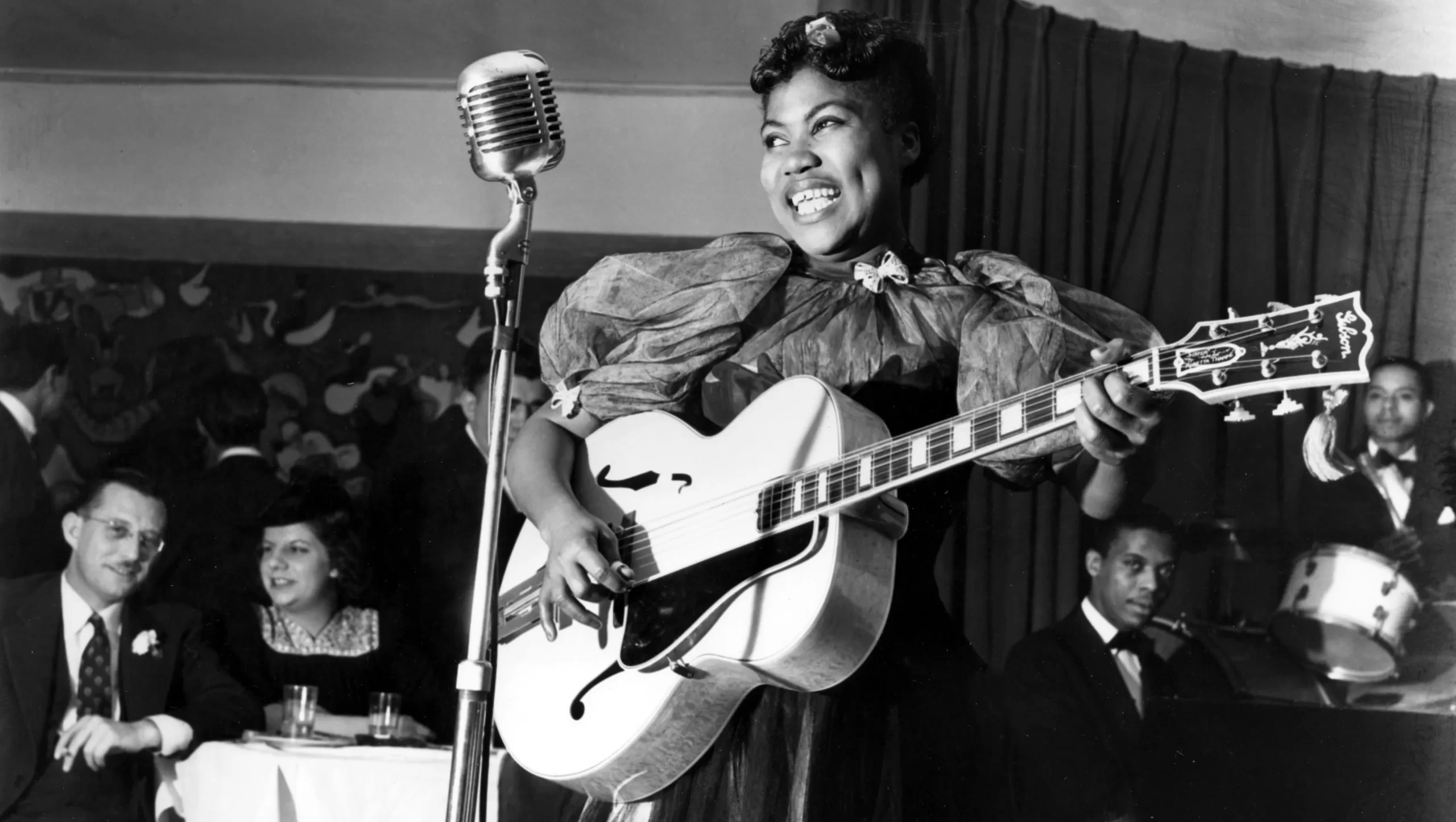Sister Rosetta Tharpe (1915-1973) was an American singer, songwriter, guitarist, and one of the most influential figures in the development of 20th-century music, particularly gospel, rhythm and blues, and rock and roll. Known for her powerful voice, electrifying guitar playing, and charismatic stage presence, Tharpe was a pioneering artist who bridged the gap between sacred and secular music. She is often referred to as “The Godmother of Rock and Roll” for her significant influence on later rock musicians.
Overview of Sister Rosetta Tharpe
- Early Life and Career Beginnings: Born Rosetta Nubin on March 20, 1915, in Cotton Plant, Arkansas, Tharpe was introduced to music at an early age by her mother, Katie Bell Nubin, a singer and mandolin player who was also a preacher in the Church of God in Christ (COGIC). Tharpe began performing gospel music in church as a child, showcasing her talent as both a singer and guitarist. By the age of 19, she had moved to Chicago with her mother and began her professional career, performing in gospel revivals and recording with the Decca label.
- Breakthrough and Blending of Gospel with Secular Music: Tharpe’s breakthrough came in the late 1930s when she began recording songs that blended traditional gospel with secular music forms like blues and jazz. Her 1938 recording of “Rock Me,” a reworking of a traditional spiritual, became a hit and introduced her to a broader audience. Tharpe’s ability to infuse gospel music with the rhythms and sounds of the blues, combined with her bold, soulful voice and dynamic guitar work, set her apart from other gospel singers of the time. Her performances in nightclubs and theaters, alongside gospel and secular artists, helped bridge the gap between sacred and secular music, making her a controversial figure in the gospel community.
- Innovative Guitar Style and Influence on Rock and Roll: Tharpe was one of the first musicians to use the electric guitar in gospel music, and her innovative playing style had a profound impact on the development of rock and roll. Her guitar work was characterized by powerful, rhythmic picking and the use of distortion, techniques that would later be adopted by rock guitarists. Songs like “Strange Things Happening Every Day” (1944) and “Up Above My Head” (1947) featured her signature guitar sound and are considered early examples of rock and roll. Tharpe’s showmanship and ability to captivate audiences with her guitar playing influenced a generation of rock musicians, including Chuck Berry, Little Richard, Elvis Presley, and Jerry Lee Lewis.
- Later Career and Legacy: Throughout the 1950s and 1960s, Tharpe continued to perform and record, often touring with gospel quartets and blues artists. While her popularity waned in the United States during the height of rock and roll, she found a dedicated audience in Europe, where she toured extensively. Tharpe’s influence became more widely recognized in the decades following her death on October 9, 1973, as musicians and historians acknowledged her role in shaping the sound of modern music. In 2018, she was posthumously inducted into the Rock and Roll Hall of Fame as an Early Influence, cementing her place as a pioneer in the history of rock music.
Impact on Music and Culture
- Pioneering Role in Rock and Roll: Sister Rosetta Tharpe’s blending of gospel with blues and jazz laid the groundwork for the emergence of rock and roll. Her electrifying guitar style, which combined rhythm, melody, and percussive elements, was a direct precursor to the techniques used by early rock guitarists. Tharpe’s influence on rock and roll is profound, and she is often credited as one of the genre’s founding figures, despite being underappreciated in her time.
- Breaking Barriers for Women in Music: As a black woman in the early to mid-20th century, Tharpe broke numerous barriers in the music industry. She was one of the first female guitarists to achieve national prominence, and she did so in a genre that was predominantly male. Tharpe’s success as a performer and recording artist paved the way for future generations of female musicians, particularly in the realms of rock, blues, and gospel.
- Influence on Gospel and Secular Music: Tharpe’s ability to seamlessly blend sacred and secular music influenced both gospel and popular music. Her performances in secular venues and recordings of gospel music with secular overtones challenged the norms of the time and expanded the audience for gospel music. Her work inspired countless gospel artists who followed, as well as secular musicians who were drawn to her powerful voice and charismatic stage presence.
- Cultural and Musical Legacy: Sister Rosetta Tharpe’s legacy is now more widely recognized, with her contributions to music being celebrated by both musicians and historians. She is remembered not only as a trailblazing guitarist and vocalist but also as a cultural icon who challenged conventions and paved the way for the integration of gospel, blues, and rock. Her posthumous recognition, including her induction into the Rock and Roll Hall of Fame, reflects her lasting impact on the music world.
Sister Rosetta Tharpe – Best Performance Videos and Songs – Playlist:
References
- Wald, Gayle. Shout, Sister, Shout!: The Untold Story of Rock-and-Roll Trailblazer Sister Rosetta Tharpe. Beacon Press, 2007.
- Heilbut, Anthony. The Gospel Sound: Good News and Bad Times. Limelight Editions, 1997.
- Guralnick, Peter. Sam Phillips: The Man Who Invented Rock ‘n’ Roll. Little, Brown and Company, 2015. (Includes context on Tharpe’s influence on early rock)
- Rock and Roll Hall of Fame. “Sister Rosetta Tharpe.” Rock Hall, 2018.
- Vinson, Christina. “Sister Rosetta Tharpe: The Godmother of Rock and Roll.” The Guardian, 2017.


Leave a Reply